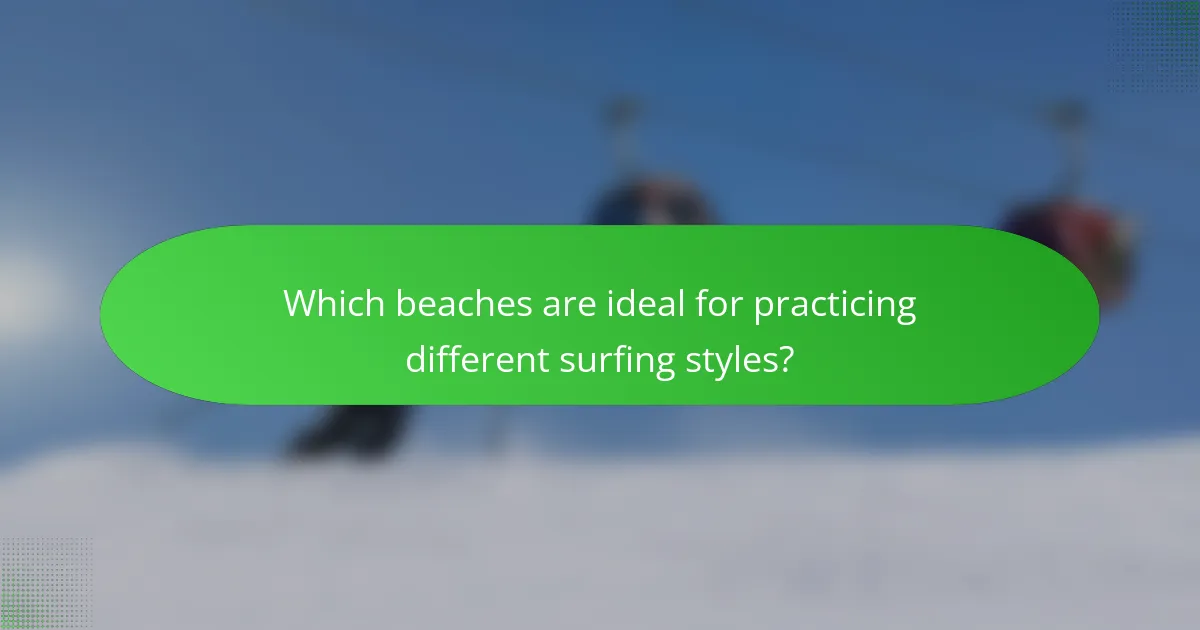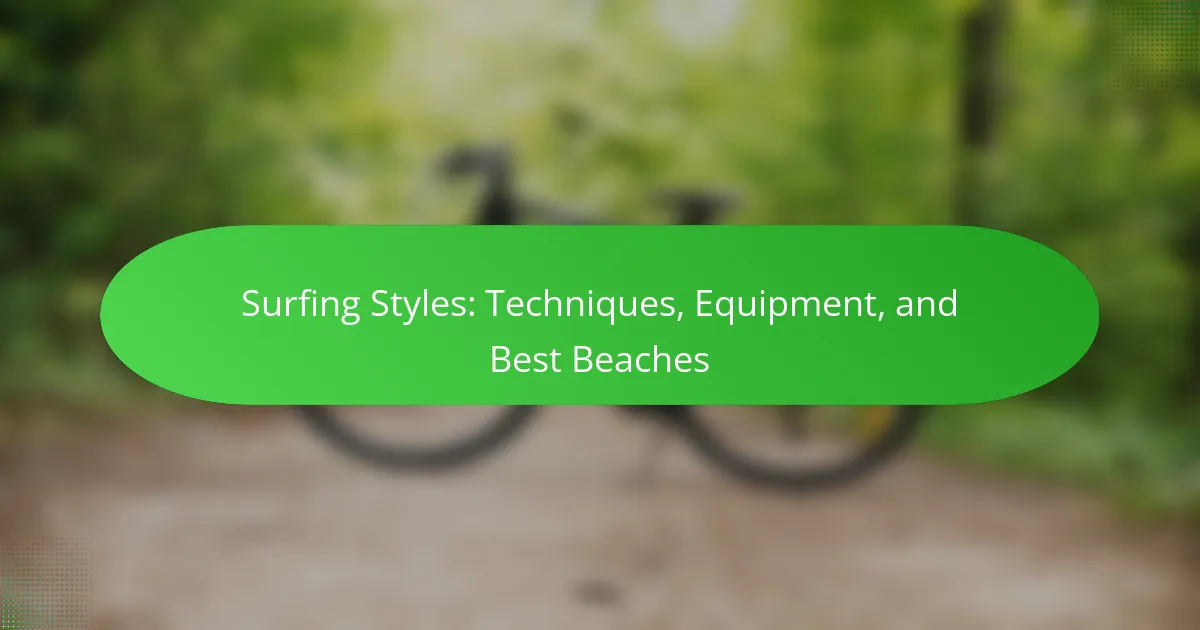Understanding different surfing styles can enhance your experience on the waves. Explore the techniques unique to shortboards, longboards, fish boards, and hybrids. Learn about the specific equipment needed for each style and discover the best beaches suited for various conditions. Mastering these elements will help you navigate challenges and improve your surfing skills.

What are the different surfing styles and their characteristics?
Surfing styles include shortboard, longboard, fish, and hybrid, each with unique characteristics. Shortboarding emphasizes speed and agility, while longboarding focuses on smooth, stylish rides. Fish boards are wider and shorter, ideal for smaller waves, and hybrids combine elements of both shortboards and longboards for versatility. Each style requires specific equipment suited to its technique and the best beaches for practice vary by wave conditions and surfer skill level.
How does each surfing style cater to different skill levels?
Different surfing styles accommodate varying skill levels by emphasizing distinct techniques and equipment. Beginners often start with longboarding, which offers stability and ease of paddling. Intermediate surfers might prefer shortboarding for its maneuverability, while advanced surfers often engage in big wave surfing, requiring specialized equipment and skills. Each style enhances the surfing experience by catering to the individual’s proficiency and comfort in the water.
Which surfing styles are most popular in various regions?
Popular surfing styles vary by region, influenced by wave conditions and local culture.
In Hawaii, surfers favor big wave surfing, utilizing specialized boards for extreme conditions. California highlights shortboard surfing, emphasizing speed and agility on smaller waves. In Australia, longboarding is prominent, celebrated for its smooth, stylish rides. Meanwhile, in Portugal, tow-in surfing is gaining traction, allowing surfers to catch massive waves with the help of jet skis.
Each style reflects regional characteristics, shaping the surfing experience globally.

What techniques are essential for mastering each surfing style?
To master each surfing style, practice specific techniques tailored to the style’s requirements. For shortboard surfing, focus on quick turns and aggressive bottom turns. Longboard surfing emphasizes smooth, flowing movements and cross-stepping. In paddle surfing, strength and endurance are crucial for catching waves. Lastly, tow-in surfing requires precise timing and coordination with a partner. Each style demands unique skills and practice to achieve proficiency.
How do paddling techniques vary across different surfing styles?
Paddling techniques differ significantly among various surfing styles. Shortboard surfers utilize quick, powerful strokes for speed and maneuverability. Longboard surfers often adopt a more relaxed, rhythmic paddling style to maintain balance and glide. Stand-up paddleboarders use a wider range of strokes, incorporating both forward and lateral movements for stability. Each technique aligns with the unique demands of the respective surfing style, enhancing performance and wave-catching ability.
What are the key turning techniques for each surfing style?
The key turning techniques vary by surfing style. Shortboard surfers utilize quick, sharp turns for agility. Longboard surfers emphasize smooth, fluid movements for style. Fish surfers combine speed with tighter arcs. Finally, funboard surfers balance elements of both short and longboard techniques. Each style requires specific equipment to optimize performance on the waves.
Which advanced maneuvers can enhance performance in specific styles?
Advanced maneuvers such as bottom turns, cutbacks, and aerials can significantly enhance performance in various surfing styles. Bottom turns provide speed and control, while cutbacks allow surfers to maintain momentum on the wave. Aerials showcase skill and creativity, making them essential for progressive surfing styles. Each maneuver requires specific techniques and equipment adjustments, such as board type and fin setup, to maximize effectiveness.

What types of equipment are best suited for different surfing styles?
Different surfing styles require specific equipment to optimize performance. Shortboards suit aggressive maneuvers and high-speed surfing, while longboards offer stability and ease for cruising. Fish boards excel in smaller waves, providing speed and maneuverability. Funboards blend characteristics of shortboards and longboards, ideal for beginners. Soft-top boards enhance safety for novices. Each style’s unique attributes cater to varying conditions and surfer preferences.
How do surfboards differ based on surfing style?
Surfboards differ significantly based on surfing styles, affecting their shape, size, and construction. Shortboards are designed for high-performance surfing, emphasizing speed and maneuverability. Longboards provide stability and ease of paddling, ideal for beginners and casual surfers. Fish surfboards are wider and shorter, catering to small wave conditions. Funboards blend attributes of both shortboards and longboards, offering versatility for various skill levels. Each style influences the surfboard’s performance and suitability for different wave conditions, enhancing the overall surfing experience.
What role do wetsuits and accessories play in various surfing conditions?
Wetsuits and accessories significantly enhance performance and safety in varying surfing conditions. They provide thermal insulation in cold waters, buoyancy in choppy seas, and protection from UV rays and marine life.
In warmer conditions, shorty wetsuits or rash guards offer sun protection and comfort without overheating. In contrast, full wetsuits are essential for colder climates, with thickness varying from 2mm to 6mm based on water temperature. Accessories like booties, gloves, and hoods further improve warmth and grip, making them crucial for surfers in extreme conditions.
Overall, the right wetsuit and accessories can enhance the surfing experience by ensuring comfort and safety across different environments.
Which brands are renowned for specific surfing style equipment?
Renowned brands for specific surfing style equipment include Channel Islands for performance shortboards, Lost for innovative designs, Firewire for eco-friendly options, and O’Neill for wetsuits. Each brand excels in unique attributes tailored to different surfing styles.

Which beaches are ideal for practicing different surfing styles?
Huntington Beach, California is ideal for all surfing styles, offering consistent waves. Other great locations include Jeffrey’s Bay, South Africa for longboarding, and Teahupo’o, Tahiti for big wave surfing. Each beach provides unique conditions suited to different techniques. For beginners, Waikiki Beach, Hawaii is perfect due to its gentle waves.
What factors make certain beaches better for specific styles?
Certain beaches are better for specific surfing styles due to wave conditions, wind patterns, and bottom structure. For example, beaches with consistent swells favor shortboard surfing, while longboarders benefit from mellow, rolling waves.
Factors influencing beach suitability include wave height, frequency, and direction. Beaches with steep breaks provide challenges for advanced surfers, while gentle breaks are ideal for beginners. Equipment choice also plays a role; shortboards excel in powerful waves, while longboards offer stability in smaller surf.
Additionally, local weather patterns affect wind conditions, which can enhance or hinder surfing experiences. Understanding these factors helps surfers select the best beaches for their preferred styles.
How do local conditions influence the choice of beach for surfing?
Local conditions significantly influence the choice of beach for surfing by affecting wave quality and safety. Factors such as wind direction, tide patterns, and local geography determine the suitability of a beach for various surfing styles. For instance, beaches with consistent swells and minimal obstructions are ideal for advanced surfers seeking challenging waves. Additionally, weather conditions and water temperature impact the comfort and safety of surfers, influencing their choice of location. Understanding these local conditions helps surfers select the best beaches for an optimal surfing experience.
Which lesser-known beaches offer unique surfing experiences?
Lesser-known beaches offering unique surfing experiences include Nags Head in North Carolina, known for its powerful waves and scenic dunes. Another is Pismo Beach in California, famous for its long rides and beautiful sunsets. La Gravière in France offers challenging conditions that attract advanced surfers. Lastly, Muizenberg in South Africa is ideal for beginners with its gentle waves and vibrant surf culture.

What common challenges do surfers face with different styles?
Surfers face various challenges depending on their style, including wave selection, equipment suitability, and skill level. Shortboard surfers often struggle with paddle power and maneuverability in crowded lineups. Longboard surfers may find balance and stability more challenging in choppy waters. Meanwhile, those practicing alternative styles like bodyboarding face unique obstacles such as wave timing and body positioning. Each style demands specific techniques and gear, which can complicate the surfing experience.
How can surfers overcome environmental challenges like waves and currents?
Surfers can overcome environmental challenges like waves and currents by mastering techniques and using appropriate equipment. Understanding wave patterns and current dynamics is crucial for effective navigation. Surfers can enhance their skills through practice and observation, allowing them to adapt to varying conditions. Utilizing equipment like leashes, fins, and wetsuits also aids in maintaining control and safety while surfing.
What are the most frequent mistakes made by beginners in each style?
Beginners in surfing often make common mistakes across various styles. These include poor paddling techniques, incorrect stance, failure to read waves, and inadequate equipment choices.
In shortboard surfing, beginners frequently struggle with timing their takeoff. In longboard surfing, they often neglect proper foot placement, leading to instability. In paddleboarding, a common error is using the wrong paddle length, affecting balance. Lastly, in kite surfing, beginners may misjudge wind conditions, resulting in unsafe situations.

What expert tips can enhance your surfing experience?
To enhance your surfing experience, focus on mastering techniques, selecting the right equipment, and choosing the best beaches.
1. Practice different surfing styles, such as shortboarding or longboarding, to find what suits you best.
2. Invest in quality equipment, including a suitable surfboard and wetsuit, tailored to your skill level and local conditions.
3. Choose beaches with optimal wave conditions for your experience level, considering factors like tide and wind direction.
4. Consider taking lessons from experienced surfers to improve your skills and knowledge of local surf spots.
How can surfers maintain their equipment for optimal performance?
Surfers can maintain their equipment by regularly inspecting, cleaning, and repairing their boards and gear. Consistent care enhances performance and prolongs lifespan.
1. Rinse boards with fresh water after each session to remove salt and sand.
2. Check for dings or cracks; repair them promptly to avoid water damage.
3. Store boards in a cool, shaded area to prevent UV damage.
4. Use a board bag for transportation to minimize scratches and impacts.
5. Regularly wax the board for better grip and performance.
These practices ensure optimal performance and durability of surfing equipment.
What practices can improve safety while surfing?
To improve safety while surfing, practice proper techniques, use appropriate equipment, and choose suitable beaches. Wearing a leash prevents board separation, while using a wetsuit provides thermal protection. Always check local conditions, including wave height and currents, to avoid hazards. Surfing with others enhances safety through mutual support.
Which resources are recommended for continuous learning in surfing?
To enhance continuous learning in surfing, consider the following resources: online courses, instructional videos, surf camps, books, and community forums. Each offers unique insights into techniques, equipment, and beach recommendations.
1. Online courses: Platforms like Udemy and MasterClass provide structured lessons from experienced surfers.
2. Instructional videos: YouTube channels such as “Surf Simply” and “How to Surf” offer practical tips and demonstrations.
3. Surf camps: Participating in surf camps allows for hands-on experience and personalized coaching.
4. Books: Titles like “The Complete Guide to Surfing” cover techniques and equipment in depth.
5. Community forums: Websites like Surfline and Reddit’s surfing community facilitate discussions and advice sharing among surfers.
